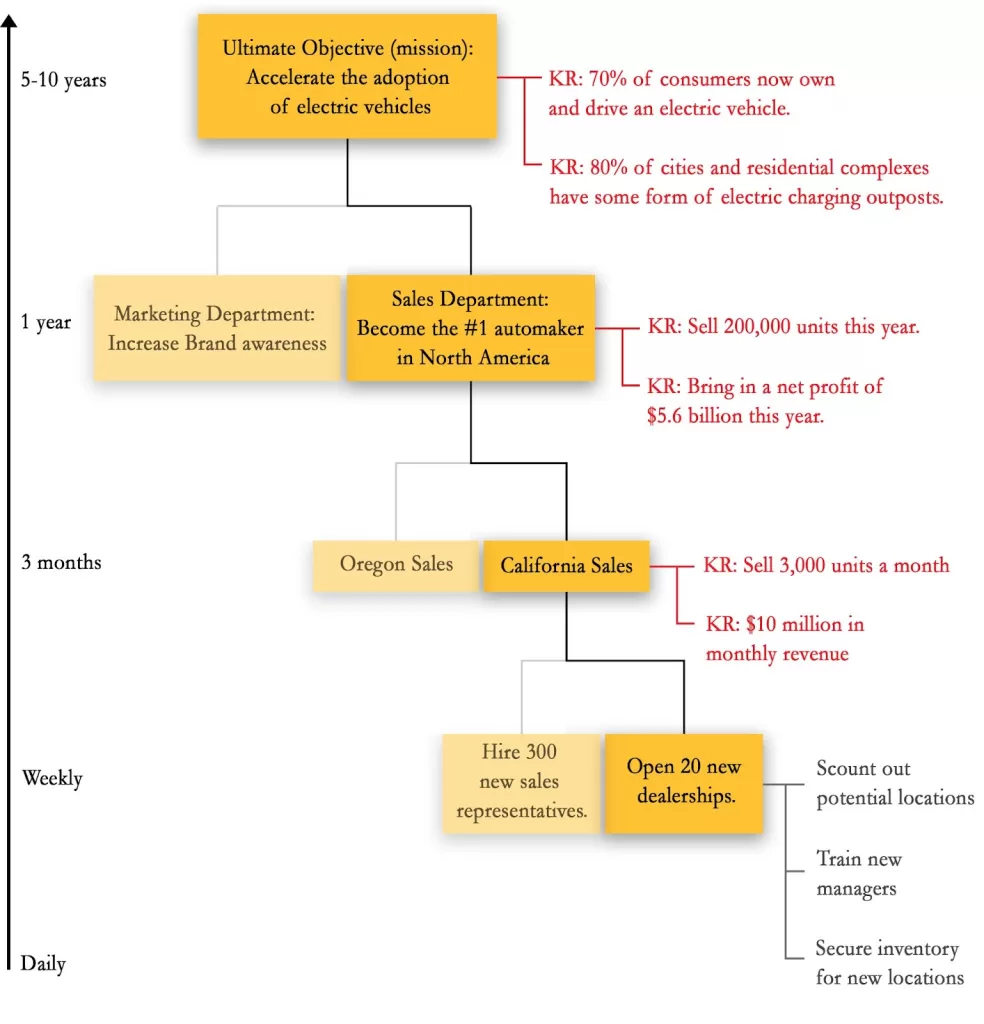OKRs: Objectives and Key Results
First introduced by Intel and popularized by Google, OKRs stands for Objectives and Key Results. This widely used goal management framework is designed to better align activities and initiatives with objectives (your goals).
Objectives (Where do I need to go?)
- A goal for the future.
- Ambitious and inspirational.
- Sets a clear direction and provides motivation.
- Your company mission/vision is typically an objective.
- Qualitative in nature and potentially hard to measure.
- Heavily influenced by factors beyond your control.
Examples:
- To become the leading X company in X region.
- To successfully capture the X market.
Key Results (How do I know if I’m there?)
- The metrics that indicate if you have achieved your objective.
- Helps measure progress toward your objective.
- Quantitative and measurable.
- If realistic, mostly under your control.
Examples:
- Close 20 new customers each month.
- Open/launch in one new location each month.
Initiatives (What will I do to get there?)
- The work you will do that might influence your Key Results.
- Activities, actions, behaviors, or systems.
- Measurable and, if realistic, fully under your control.
Examples:
- Call/Email 10 new prospects a day.
- Schedule 5 demos a week.
OKRs contain SMART elements. They’re not mutually exclusive frameworks. Good OKRs and Initiatives should also be SMART. You can also have multiple OKRs that collaboratively move you closer to an Ultimate Objective (mission/purpose/BHAG: Big Hairy Audacious Goal), example below:

Here’s a detailed example to help you understand OKRs in action:

Initiatives aren’t set at every level; they only need to be set at the most basic level. You won’t need to define Initiatives to address the “Ultimate Objective” OKR because “Company Objectives” serve as the Initiatives for it.
Using the OKRs framework to map your goals will help you and your team visualize the smaller goals that help move you closer toward a larger and seemingly far-fetched goal.
SMART Goals
Use the SMART framework to ensure your OKRs are effective and tangible:
| SPECIFIC | Focused and tangible. Otherwise, your goal may be too vague to achieve. |
| MEASURABLE | A clear definition of success to help you evaluate achievement and progress. |
| ATTAINABLE | Challenging yet reasonable. |
| RELEVANT | Does it align with your values? Will it serve you? Is it a current priority? |
| TIME-BOUND | Parkinson’s Law states “Work expands so as to fill the time available for its completion”. A specific and challenging deadline will keep you focused and disciplined to get it done. |
Examples:
Bad: I want to be more fit.
SMART: I want to reduce my BMI to 20 and achieve a beep test score of 9 by March.
Bad: I want to earn more money.
SMART: I will invest $1,000 a month into my tax-free savings investment account and leverage it with ETFs and stocks that provide a minimum 5% dividend.
Bad: I want to reduce plastic pollution
SMART: I will limit my take-out dining orders to no more than twice a week
Notice in the first example, the specific target date makes it tangible; however, the second and third examples are more effective despite not having a target date. Why? Because they encourage constant improvement while giving you a time window to assess and quantify progress. This is a good example of a system-centric goal encouraging long-term growth. The sense of momentum and progress from achieving these goals will empower you to take further action.
If you choose to set SMART goals with a time window instead of deadlines, don’t forget to periodically reflect and evaluate if the habits or behaviors attached to them are positively contributing towards your intended objective.
STOP = STOP, THINK, ORGANIZE, PLAN
Remember! The goals (Key Results) you set for your Objectives are there to serve them. They’re the means, not the end; don’t overfocus on them.
Google’s Chief Decision Scientist, Cassie Kozyrkov, shares a great example of the perils of putting your goals before your objectives in her Advanced Manual of Self-Improvement (definitely worth a read, as it discusses goal-setting beyond sales management):
“If your goal is to look your best, the point isn’t how many ounces of chocolate you do or don’t eat each day (process goal/Initiative).
The point isn’t what the scale says tomorrow morning (performance goal/Key Result).
The point is how you look in the long run (outcome goal/Objective).”
Be mindful of Goodhart’s Law: “When a measure becomes a target, it ceases to be a good measure.” When people or organizations are incentivized to meet certain targets or metrics, they may alter their behavior in ways that distort or manipulate those measures, undermining their usefulness as indicators of success or performance. The Cobra Effect is a real-life anecdote illustrating how metrics used to guide decision-making can lead to unintended consequences if not carefully managed:
During British colonial rule in India. To control the population of venomous cobras, a bounty was placed on each cobra killed. Initially, this led to a decrease in the cobra population. However, people began breeding cobras to collect more bounties, rendering the initiative ineffective. When the government realized this and canceled the bounty program, the breeders released the now-worthless cobras into the wild, resulting in a higher population than before.
A similar situation also occurred in the 1902 Great Rat Massacre of Hanoi, which even led to an outbreak of the bubonic plague, claiming the lives of over 263 people. Never pursue your Key Results for their own sake, continuing Cassie’s example:
“Imagine that your outcome goal (Objective)is better health and your performance goal (Key Results) is your weight. At first, you’re cutting out junk food, but as the days go by you notice that you’re able to get an even better score in the game of Weigh Yourself by drinking less water, taking diuretics, making yourself sweat, and eating all kinds of non-nutritive chemistry experiments. When you see the scale, you’re chuffed… but what about that overall outcome goal? Your health will be a wreck if you keep this up. Clearly, the scale has ceased to be a good measure of your health since you’ve started gaming it in a way that’s destructive to your overall goals.”
It’s also okay to change your objectives if they are no longer appropriate for serving you and your organization! Doing so doesn’t make you a cop-out or someone incapable of seeing your goals through to the end. There’s a difference between changing or abandoning a plan as an excuse and recognizing when it’s no longer the right plan.
Don’t fall prey to sunken cost fallacy: the cognitive bias that occurs when one continues to invest resources (such as time, money, or effort) into a project, endeavor, or decision solely because they have already invested a significant amount, even though the investment is unlikely to yield favorable outcomes in the future. It happens because we often feel emotionally attached to our past investments and are reluctant to abandon them, even when doing so would be the most logical choice. Try not to let past investments influence your decisions about whether to continue investing more resources.
A simple example of this is how many of us are inclined to continue watching a bad movie or TV series because we’ve already invested money in buying the ticket or time watching a portion of it.
In sales, this could also manifest as an unwillingness to abandon certain prospects or campaigns because of prior investments in them. Worse yet, some organizations abuse this fallacy to manipulate their prospects. They do so through an overly vigorous qualification process, not designed so much to disqualify prospects who aren’t interested or a good fit; but instead to deliberately get prospects invested.
What might this look like? Not to encourage you to do so, but rather to raise awareness so you can call it out if you see it.
- Intentionally making prospects jump through hoops to prolong the negotiation process.
- Falsely “allowing” a customer to speak to their manager, even though they may have been able to resolve the inquiry themselves.
- Subjecting a prospect to an “initiation” or ritualistic process before allowing them into a program.
But I digress, let’s return to the topic of goal setting!
Set up regular reminders to STOP (STOP, THINK, ORGANIZE, PLAN) and reflect (monthly, quarterly, yearly). Review results, evaluate if you’re measuring the right things, and ensure you are making progress in the right direction. Your goals should always serve your ends, not your means; course correct if your actions or initiatives aren’t contributing towards your goals, or if your goals are no longer contributing to your objectives. Don’t be overly attached to the resources you’ve invested in a campaign if it’s no longer serving you. Changing your approach does not mean you have failed.
Upon reviewing this section, I realized “goals” might be confused with “objectives”. Specific to this section, objectives are used in reference to the OKR framework. Akin to vision/mission. Goals are the measurable key results.
ASSIGNMENT
Using OKRs: Map out organization-wide vs. department Objectives & Key Results and identify potential Initiatives.
Ensure they are SPECIFIC, MEASURABLE, ATTAINABLE, RELEVANT, and TIME-BOUND.
